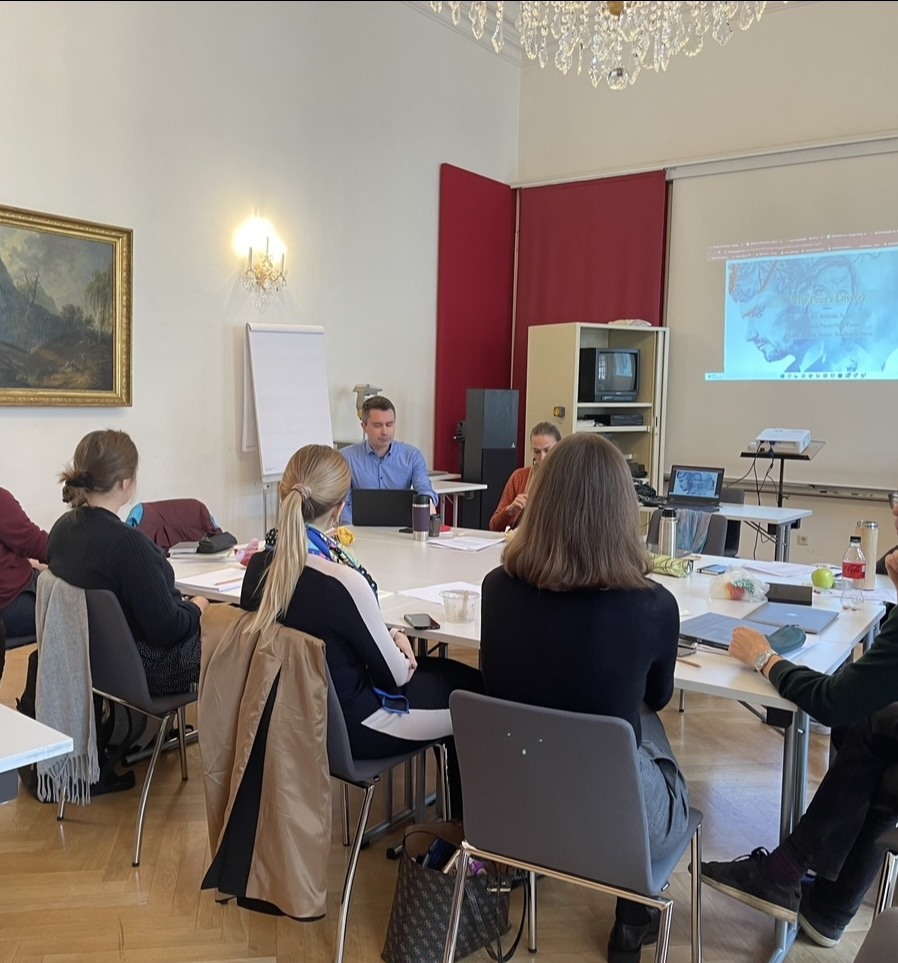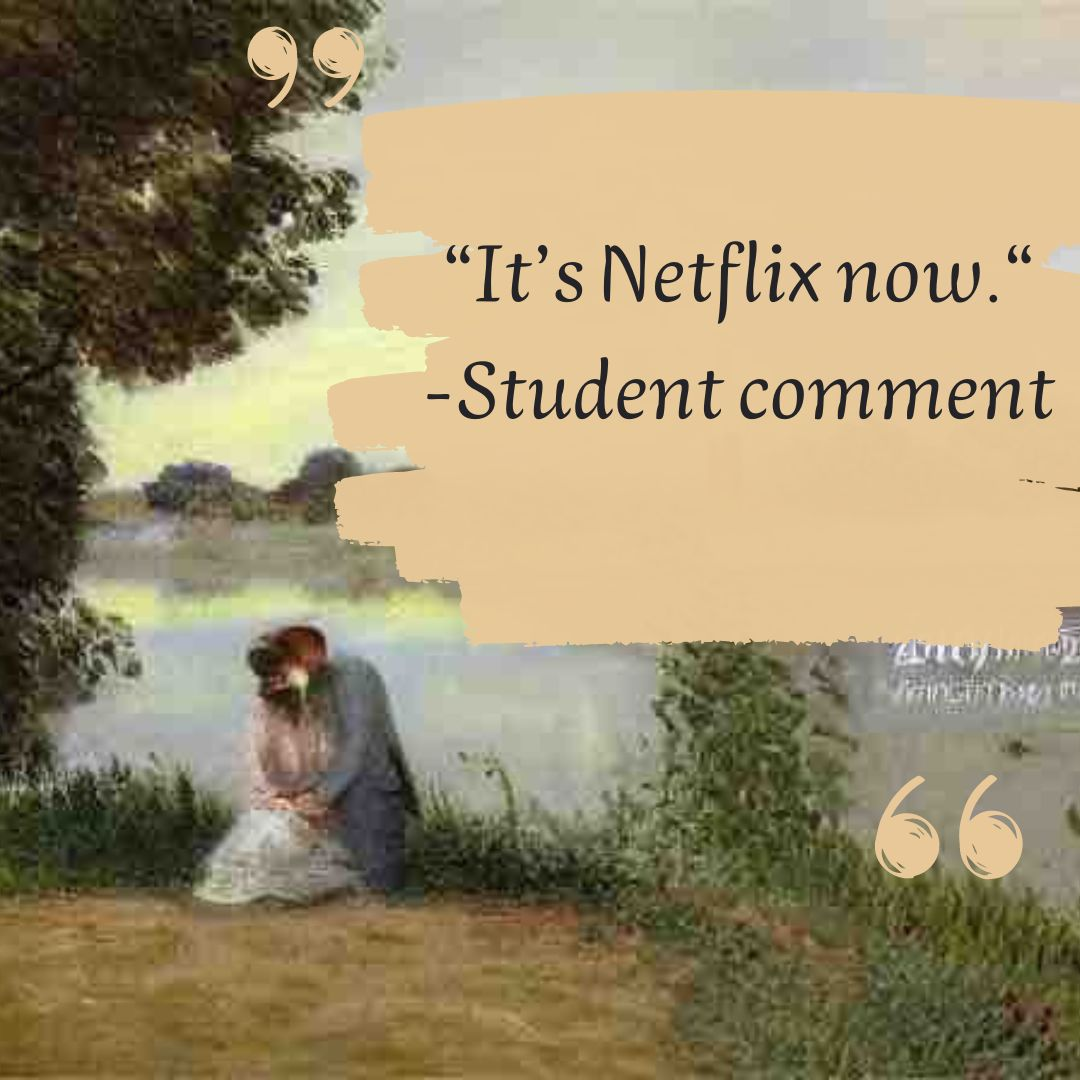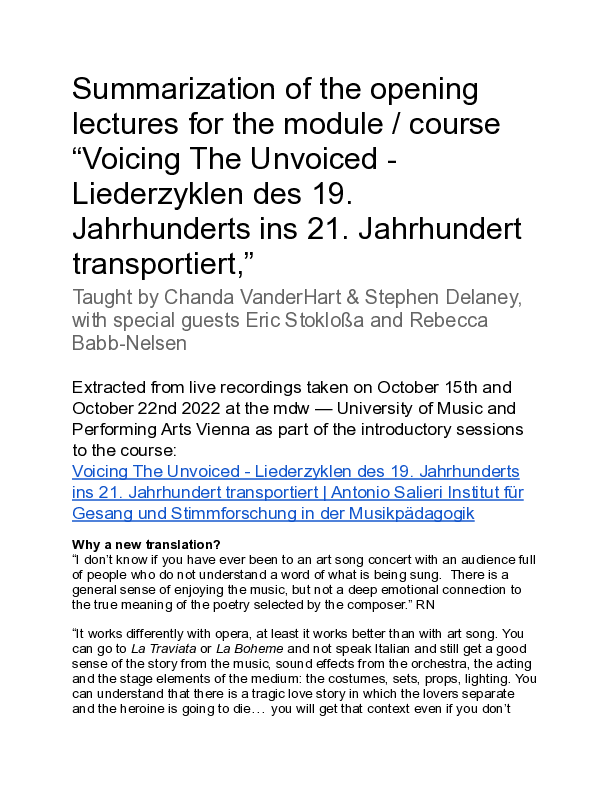The Origins
Stokloßa, the singer in the recordings and instigator of the project, explains the genesis of The Poet’s Love(r) to the students:
Just to give you some background about the project, and how it came about, I started my professorship in Texas four years ago, and part of my academic work at the University is research. I was wondering, what can we do? What would be a good research project? So, we considered doing translations. And I thought, actually, I’ve sung all the big German cycles so many times, and I think there’s no good poetic, singable translation to any of them: Dichterliebe, Die Schöne Müllerin, and Winterreise. So, since Rebecca has a master’s degree in German Literature, and is a singer, she said, ‘I think we can pull this off, starting with Dichterliebe.’
VanderHart, the pianist in the recordings and a musicologist, describes the original intention of the project: ‘Originally, we were planning to do parallel English and German versions and then we did the English and we thought, “No, it’s good. We don’t need to make another German language recording”.’
Babb-Nelsen, a professional classical singer, who holds a master’s degree in German Literature, is the project’s translator and poet. She explains how an additional dimension evolved that changed the course of the project. In addition to translating the sixteen poems taken from Heinrich Heine’s Lyrisches Intermezzo for Dichterliebe, she was inspired to write sixteen original poems from the perspective of the woman described in the cycle, the eponymous ‘Poet’s Lover’:
As I dug into the pure translation work of the cycle, because Chanda and I have talked a lot about gender studies as well, it just started to rankle me the way the young woman in the story is portrayed. It actually came out of a real need to set the story straight for me - after doing so much intense work with the poetry, and spending so much time with each individual song when translating. I also thought, ‘this is so one-sided’. One feels like the female character in the cycle is almost maligned from this perspective, that she’s this heartless person that loves him and leaves him, and he’s suffering and she doesn’t care. That’s kind of the feeling that you get. I felt a driving need to find a voice for this unvoiced character.
Babb-Nelsen titled the set of sixteen original poems Her Side. She explains that not everyone in the team had an initially positive reaction to this idea, which leads to humorous banter between the three colleagues: ‘It was really fun when I told Chanda about that. She was also not super thrilled about the idea.’
VanderHart interjects, ‘I said, “I’m interested, but do we really want to try to do that?” Because it could have been very kitschy. Something like that could go either way; it could be shit. And then they’re my friends and I would have to say, “no, this is shit”.’
‘Exactly,’ Babb-Nelsen laughs.
‘Which you would do,’ Stokloßa insists.
‘I would 100%,’ VanderHart replies, then assures the students that she has since been convinced of the artistic merit of the new poems: ‘I’m now firmly on the other side of the barrier.’
Motivation — Why a New English Version?
Babb-Nelsen delves into the motivation behind this project:
I don’t know if you have ever been to an art song concert with an audience full of people who do not understand a word of what is being sung. There is a general sense of enjoying the music, but not a deep emotional connection to the true meaning of the poetry selected by the composer. It works differently with opera, at least it works better than with art song. You can go to La Traviata or La Bohème and not speak Italian and still get a good sense of the story from the music, sound effects from the orchestra, the acting and the stage elements of the medium: the costumes, sets, props, lighting. You can understand that there is a tragic love story in which the lovers separate and the heroine is going to die… you will get that context even if you don’t understand a word of the language in which the opera is being sung. In an art song concert, that context is mostly stripped away leaving only the pianist, the singer, the music and the text, and if the text is incomprehensible to the audience, it is as if a leg has been sawed off the table.
In discussion, one female student discusses the relevancy of the project from her own perspective:
It was funny because I was just talking to someone about Lied because I was studying in England. He works in Berlin and was saying that in England he finds their approach especially conservative because they don’t have the language. So, they really approach it conservatively and for him, it doesn’t express anything, because it’s not the native language and so you’re singing these song cycles to people who don’t understand them. This is just such a great way to make these Lieder accessible to the English-speaking world. It is so cool.
Babb-Nelsen argues that reading program notes is not a true substitute for hearing art song in words that one can intrinsically understand:
If you look at right brain vs. left brain activity when somebody goes to a concert and they are enjoying the concert and experiencing it, they are fully in the creative side of their mind. If you hand them a piece of paper and tell them they have to read it to understand the art, the analytical part of the brain turns on, arguably pulling the listener out of the moment. What we want to do with this endeavor is to make it possible for a non-German speaker to enjoy Dichterliebe without having to go into the analytical part of their mind — to be able to fully enjoy it in a way that is more organic. So, this was our idea and attempt.
Different Layers of Translation
Babb-Nelsen takes the students through an exercise in which they collectively come up with the challenges of translating different types of texts:
‘Regarding the translation of texts, there are multiple layers of difficulty that increase depending on the type of text being translated.’
‘When translating purely technical writing — an operations manual for an electrical appliance, for example — all one needs to focus on is basic information, meaning and clarity. The writing does not need any particular form or style, the translation must simply take a text in a language the reader does not speak and substitute the simplest, most clear version of the same information in the target language.’
‘When translating prose, for example a fictional novel by a famous Author like Paulo Coelho, suddenly there are artistic layers of complexity to consider — on top of the literal meaning of the text, one must consider figurative meaning, cultural nuance, implication, connotation, and most importantly the individual author’s style. The style element is arguably the most difficult for the translator, who must attempt to shape their literary fingerprint into the closest possible approximation of that of the author, but in a different language.’
‘Translating poetry becomes even more challenging with more constraints and layers of complexity added, including: rhyme scheme, rhythm, meter, stressed syllables, onomatopoeia, and word painting.’
‘Translating poetry for use in an art song presents yet more hurdles. As a translator of poetry for art song, you are working with a text that has already been interpreted musically by the composer, and it is your task as the translator to fit your interpretation of the poem into a filigree corset of melody, musical stresses of specific words, vowel placement, singability, intertextuality, a textual connection to the period of time in which the music was composed, and understandability vis-a-vis a listening audience.’
Found in Translation
Stokloßa tells the students about an unforeseen, but fortuitous, side-effect of the project in regard to his relationship to and understanding of the original work:
When we started to really work on the English versions, I started, even before I knew about the original poems from the woman’s perspective, to feel differently about the whole cycle. I started to feel, in a way, even though German is my native language, and even though German is in my opinion the most poetic language in the world, that I understood Heine better singing in English. I can’t explain to you why, because ultimately, it’s a translation, so it’s an interpretation, but it made me feel differently singing it in English, and I felt even better singing it in English. So, in a way, adding to what we’ve heard before about what translations are for and why we do this, I think a translation is also always a chance to rethink; it’s always a chance to reimagine poetry. Because in a way, sometimes if you are introduced to one piece of poetry in your own language, it also really depends on how was it presented to you when you heard it at first. Did you just read it? Was it sung to you? Did you hear it on the radio or in a concert? There are so many different ways. How did you feel in that moment? And that kind of sets the basis for your understanding of specific pieces. And in this case, I had all of this knowledge from the German language before and then did it in English. And to me, it set the story straight. It kind of made much more sense when I started singing Dichterliebe in English.
The Poet’s Love(r) in Performance
The Poet’s Love(r) is intended to be presented as a complete concert program, with alternating songs and poems, performed by Stokloßa and VanderHart and read by Babb-Nelsen, which gives the audience, in the opinion of the creators, a more equitable portrait of the tragic young couple. VanderHart explains that the practice of alternating Lied with poetry was actually well-established in salon tradition — a specific area of expertise for VanderHart and the subject of her Ph.D. dissertation:
As a musicologist, declamation was such a part of art song culture in the salon. The feeling between spoken text that you would read together and engage with these new books, in the reading circle, and then singing poetry — that happened really freely. Then, the borders between it were not so strong. And I kind of like that. I kind of like the mixed-media sort of feeling of it and that there’s this historical precedent. And I don’t think we do a lot of reading poetry out loud, especially not in English.
Babb-Nelsen adds: ‘And we think that can actually add a very nice element for the audience as well. Because this can happen when you’re in an art song recital, that it sort of sinks into the monotone. You keep hearing the same voice with piano through the entire evening. And as wonderful as the music is…’
VanderHart offers: ‘…maybe variety is nice too.’
‘You need to process it too,’ Stokloßa contributes. ‘The audience needs to process what they’re listening to… So, the poetry doesn’t only counterbalance the singing and the music, it also counterbalances thought.’
Inspiration
Babb-Nelsen illuminates the inspiration for much of the original poetry in ‘Her Side’:
I found a lot of her stories in the music and in the piano. There’s a softness in so much of the music, and Chanda plays it so beautifully. When he (the poet) sings about how much he loves her, it’s so touching and it’s so true that if he was in love with some soulless harpy, it wouldn’t sound like that. Honestly, I find it makes a much more beautiful story if it is this real love. If it is the unfortunate circumstance of the time and not the people themselves that were keeping them apart, and there were so many stories like this one. I think it lends more credibility to his story as well, because what he felt was real. He wasn’t a stalker who had one date with a woman and decided they were getting married. I think that this was a real, true connection. These two people fell deeply in love with each other, but because of the time and societal constraints and the fact that he was this penniless poet it couldn’t work.’
VanderHart adds: ‘What I think comes so strongly through Rebecca’s poetic commentary on this piece and how she translates the poetry too is her love and respect for these two characters. And that’s just another example of how you personally read something, and how that affects how you then interpret it.’
Babb-Nelsen expounds on the theme of truth in poetry: ‘I find that I’m the most honest when I’m writing poems. Sometimes things come out of you when you are writing poetry that are truer than you could say in prose.’
A Unique Voice
Babb-Nelsen describes the voice she decided to give to the female object-turned-protagonist and how it differs from the voice she chose to use when translating Heine’s poems: ‘She’s much more down to earth, less figurative language, less poetic.’
VanderHart interjects: ‘She’s got other problems.’
Nelsen replies: ‘Yes, this is true. You’ll see that later. But it stays throughout the cycle that way. She is more down to earth, she is not a highly figurative poet. Her poems are more about what she is experiencing and live less in the realm of metaphor whilst expressing a frank honesty about the precarious nature of her situation.’
In a side-by-side comparison of their fateful tryst, the poet’s words present a highly metaphorical language:
I’ll pour my dear soul like a river
In the cup of lily’s perfume
The lily should softly whisper
A song of my love’s first bloom
The song should shiver and glisten
Like a kiss from her sweet lips
Once she to me has given,
Time wonderf’ly sweet eclipsed.
His extremely poetic portrayal contrasts starkly with his lover’s more factual description of the same event:
We meet in secret one last time,
I carry out my plan.
I give my heart, my soul, my all
To my beloved man.
There’s pleasure, but there’s also pain,
In this, our final tryst,
I feel his heart beat in my chest,
He feels my heart in his.
And I profess my deepest love
But cannot hide my sorrow,
Because I know that this pure bliss,
Will die upon the ’morrow.
He holds me tight as we embrace,
I fight the pain inside,
If only he had means to wed,
I would become his bride.
The societal and religious pressure especially vis-à-vis the evergreen cultural theme of ‘purity’ faced by the female protagonist is something that Babb-Nelsen has experienced in her own life and was therefore able to write about with authenticity. She states: ‘Well you know, I didn’t live in the time period that she lives in, but I did live in the South, in Texas, which is very religiously conservative, and so this element of pressure from society and the religious world — that they are weighing down upon a person, I am very intimately aware of, and so I was able to bring that color to this.’
The weight of this pressure is specifically expounded on in the female protagonist’s poem ‘My Mother is an Empty Shell’, which tells the story of the female protagonist’s mother and her obsession with marrying her daughter off as a pure virgin — an obsession that is fueled by the story of the mother’s sister who committed suicide after falling pregnant with an illegitimate child.
VanderHart makes sure the class understands the implications of this history for the female protagonist when she realizes that she has fallen pregnant with the poet’s illegitimate child: ‘Did you guys understand the poem? What have we learned then about her perspective and through those two very brief poems?’
‘That she has no choice,’ a female student answers:
‘That she’s got no choice, and that there’s a whole family history that feeds into this as well as all the social constrictions and constraints of the time. And this is a completely realistic thing that happened all the time. Women were first of all, committing suicide very, very, very often in both the eighteenth and the nineteenth century. We’ll talk about that a little bit later, but illegitimate children were a massive issue. They were incredibly scandalous and would ruin social chances.’
Babb-Nelsen explains that she wrote many, but not all, of the female protagonist’s poems to correlate directly with the translated Heine poems. Notably each of the lovers has a poem about her wedding. Babb-Nelsen comments:
I don’t know if any of you have ever had the experience of being at a celebratory event when you didn’t feel like celebrating. It is one of the worst feelings. Where everyone is happy and you’re trying to just get through the evening. And I was imagining that this is what she’s going through. And now imagine you’re being forced to marry someone you don’t love. This wasn’t your choice. You look across the room, and there he is. How is this for her? So I tried to put that into words.
Reactions
VanderHart, Stokloßa, and Babb-Nelsen presented excerpts of their work, both the translated and recorded songs of Schumann and Heine as well as the original poetry by Babb-Nelsen to both classes and received an overwhelmingly positive response from both groups. One student said: ‘You know, with this part, I’m more sympathetic and empathetic towards both of them. I just feel like I want to go to both of them and tell them “It’s going to be ok.”’
Stephen Delaney, one of the course’s co-directors, who was introduced to the Poet’s Love(r) for the first time in the lecture, observed:
‘What I also believe, because I’ve been thinking about this a lot, what I really appreciated and what I found very touching and honest is: that it’s not like you’re trying to justify yourself, it’s not like you’re defending this girl, there’s nothing to defend, and that makes a greater impact.’
In both classes, at least one student said in a positive manner, that this new, added perspective had an element of ‘Netflix’ to it, one student even adding that the birth of the child at the end of the cycle hearkens the next season of the ‘show’.
Here is a larger exchange that highlights more of the positive comments from the students, starting with a statement by Stokloßa:
‘It evolved into this, where we would add the original poetry, and for me as a German, it gave me a completely new perspective of the whole subject of Schumann’s songs in general, where I, because I didn’t do it in my own native language, got deeper understanding of what it actually means. That it sounds so weird, but there it is.’
A female student interjects: ‘You really need to go to the essence of it. Expressing it is different, and so you express a different facet of the story.’
‘Correct,’ Stokloßa says.
‘How is it for you?’ VanderHart asks a male student.
‘Same. The translation is so deep,’ the student answers, ‘and if you take the translation and the original, the German, and you have to think about — it’s a new life and a new perspective to you.’
Another female student approaches Babb-Nelsen after the formal closing of the seminar, but still on the recording: ‘I loved the poems! Honestly, it’s so good, they have so much depth. It’s such a great project!’
‘I like them both so much more’
Students first contemplated what they could extrapolate from the Dichterliebe text — reading and listening through Heine’s text and Schumann’s musical setting — about each key character. They recognized quickly that they knew almost nothing about the female subject, and certainly nothing positive. She betrayed the male protagonist, quickly married someone else (which seems fairly heartless) and apparently drove him mad with grief. Interrogating their own feelings about the male protagonist, though one student recognized that ‘it is kind of nice that men were allowed to be so emotional and vulnerable at that time;’ he was primarily characterized as ‘sad,’ ‘suffering,’ ‘pale,’ ‘whiny,’ and as ‘an unreliable narrator.’
The suffering artist trope is nothing revolutionary today in an age where depression, particularly situational depression, is accepted as a standard part of many humans’ experiences, and it is perhaps harder today to empathize with a continuously suffering main character without more context. Interrogating our own feelings, even we three authors, lovers of this music and this poetry, must admit the occasional desire to shake our poet, and encourage him to pull himself together and find a good therapist.
Final Thoughts
Babb-Nelsen sums up the intended impact of this project:
I find that it’s a way to make something that we love and respect, make contact and touch an audience that may otherwise not be able to make a connection to it. And the main audience that we did this for is a predominantly English-speaking audience. But as Chanda mentioned, I do believe that there is value also for a German speaking audience in this experience.’ She adds: ‘It was a beautiful experience getting to work with these two and watch them record these new translations.
VanderHart adds that she believes a recital featuring unorthodox interpretations of known works is absolutely justified and valuable:
From my perspective as a historical musicologist, Lied was always a very vibrant and very socially engaged form. It wasn’t something that people just did in this one format. And we’ve narrowed the way we experience art song to this one very, very specific, very narrow thing that doesn’t reflect the rainbow of what used to be art song. That really engaged with people and with social concerns and with politics and with life and was performed in churches and bars and people’s houses and salons and all sorts of different functions. So, I hope what all my study of Lied has given me, and what I hope to convey the most urgently to all of you is that just that you can feel really free. There’s nothing that you can’t do with song. It’s song. And every experience I’ve had playing with it has never taken anything away, for me, from the original. It’s only added to my understanding of how it’s traditionally done, and allowed me to engage much more deeply with a text and feel much more personally connected with it.
Stokloßa closes with the thought: ‘I think this is the greatest outcome you can wish for when you do a project like this — that it actually goes in a completely different direction from what you’ve thought and you actually feel much better about your entire project after having gone in a different direction, and that’s the beauty of doing academics, of doing research. It’s opening up new worlds to our beloved art form.’



